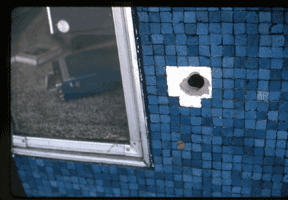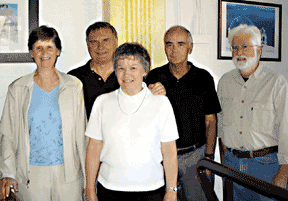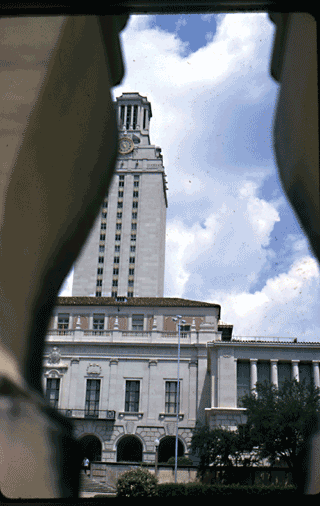 |
|||||||||||
|
|||||||||||
|
|||||||||||
Hostile Fire
|
|||||||||||
 |
A bullet hole in a store just off campus. |
• • •
Gary was a large guy, dark hair, a square face; he had grown up hunting and knew guns. On the east slope from the tower, policemen hunkered on the edges of the terraced lawn.
Then we knew what was happening. We realized that if we could see the tower, the shooter there could see us.
Police handguns wouldn’t reach the top of the tower, Gary explained.
• • •
We turned back to make our way around big, blocking Garrison. We needed to see what was happening. That was at the plaza on the south side of the tower.
People hustling between the buildings were in clear view of the tower. Maybe they didn’t understand their peril.
In the center of a flat, cemented plaza beneath the tower stood a tall flagpole flying the Stars and Stripes. Opposite the tower, the end of the plaza was framed by a colonnade baluster supported by a retaining wall. Protected by the wall, Gary and I worked our way to the bottom of the wide stairs ending the plaza.
A waist-high hedge held us to the wall; it was tough to negotiate with my stiff leg. I thought about my mother and what she would think. Later she confided, “I knew you had sought a safe place.” In reality, I’d sought the action.
The stairs above us led to a grassy lawn, then to a large reflection pond that sloped down again, the terracing effect leading to a view of downtown Austin and the state capitol.
The view was violated by a victim shot on the far side of the reflection pond, 500 yards distant.
“With that magnum, the sniper can accurately shoot past that far terrace,” Gary explained. It was a half-mile away.
That meant that anyone walking on the street, on the western side of the plaza, was in easy range of the sniper. Guadelupe Street had a series of small stores; people stepping out would be unaware of their utter vulnerability. Some people had already been killed; store windows were rent with large and small bullet holes in the plate glass.
• • •
Reaching the southeast edge of the plaza, we saw two bodies, one perhaps 20 feet from the far edge of the stairs. A woman was crouched at the bottom of the flagpole, its concrete base and thick taper her sole protection.
Tucked behind the wall and trapped by the hedge, we could see people across the stairs, a mirror of our cluster free of bushes, scoping out the plaza and the tower. Bob Zahn was among them. He had to have crossed the stairs in plain view of the sniper to get there.
A student and visiting professor, we later learned, had been killed on the plaza; a policeman was shot through the balusters near where Bob was huddled. One woman lying on the plaza was still alive.
The cluster seemed to be trying to figure out what to do. They were afraid to go out to get the wounded woman.
Behind them, a man ripped off his shirt. When it seemed the gunshots were on the far side of the tower, the man bounded the stairs to the woman. He struggled to lift her up. Bob Zahn the comedian — but not others — joined him to carry her down to safety. You can never predict who has courage.
The first rescuer was an ex-Marine. He was later fired from his work with a construction company because he had gone off the job to get to the tower.
• • •
The sniper, Charles Whitman, was also ex-military, ex-Vietnam. He reportedly had a small, undiagnosed brain tumor, but that didn’t fully explain the random carnage. He killed 14 that day and wounded 31.
Romero Martinez and Houston McCoy from the Austin Police Department took the elevator up the tower, then climbed the remaining stairs to the reception area for the observation deck. Whitman was on the northwest corner of the deck, looking toward Guadelupe Street. The patrolmen stepped out and around the eastern corner. Martinez shot first. Ninety minutes after the first pop, there was silence from the tower.
Silence.
 |
The writer, left, reunited 40 years later with fellow Peace Corps students, including hero Bob Zahn, second from left. |
• • •
But no one was untouched. From then on, no matter where we were on campus, we would look to the tower. If we could see it, the tower could see us. We took quick reconnaissances to know where to dive if we heard gunshots. That was the primitive, turtle part of our brains acting from a deep survival instinct.
Virginia Tech’s survivors are now in the shadow, reliving how to survive when it happens again.
Sandy Anderson went peg-legged to teach English at Girls Middle School in Gaziantep, Turkey. She returned two years later to teach in the post-riot schools of Washington, D.C. She earned her Ph.D. from Virginia Tech in 1988 and worked for 30 years in D.C. Public Schools Dept. of Planning and Program Development. She and her husband Charlie — parents of two daughters — moved in 2002 from Northern Virginia to St. Leonard.
|
Current Issue \\ Archives \\ Subscriptions \\ Clasified Advertising \\ Display Advertising |

